Chapter 14
JavaScript and Forms
Key Skills & Concepts
• Accessing Forms
• Using the Properties and Methods of the Form Object
• Ensuring the Accessibility of Forms
• Validating Forms
• HTML5 and Forms
When you use JavaScript to access forms, you can create new scripts for your Web pages. This chapter begins by explaining how to access a form with JavaScript. Then you’ll learn about the various properties and methods to use with forms and form elements. You’ll also learn about forms and accessibility, how to validate form elements, and how to use <select></select> elements as navigational tools.
Accessing Forms
Each time you add a set of <form> and </form> tags to an HTML document, a form object is created. To access one of the forms using JavaScript, you can use any one of the following options:
• Use the forms array of the document object
• Name the form in the opening form tag and use that name to access the form
• Give the form an id in the opening form tag and access it using the document .getElementById() method
Using the forms Array
The forms array allows you to access a form using an index in the array. Each set of <form> and </form> tags on the page will create an additional item in the forms array, in the order in which they appear in the document. Thus, you can reference the first form in a document like this:
As you will recall, arrays begin counting at 0, so the previous example will access the first form in the document. If you want to access the second form, you could use the following:
This will work for the rest of the forms on the page in the same way. Just remember to begin counting at 0 rather than 1 to access the correct form.
Accessing the form doesn’t do anything on its own. The form that you access is an object. To use it, you need a property or method of the object. The properties and methods of the form object are listed in a later section, “Using the Properties and Methods of the Form Object,” but for now, take a look at the length property to see what it does.
A Property Value
The examples in this section use the form object’s length property. This property allows you to find out how many elements exist (such as input boxes, select boxes, radio buttons, and others) in an HTML form. For example, take a look at this code:

The code creates a short form that contains three elements: two text boxes and the submit button. Because it’s the only form on the page, it will be the first form, allowing you to access it using document.forms[0]. To use the length property, add it to the end like this:
Using the preceding code, you can create a short script to tell the viewer how many elements are in the form. The code that follows will write the information on the page after the form:
This code informs the viewer that the form has three elements. Figure 14-1 shows this script’s results when using the example HTML code shown previously.
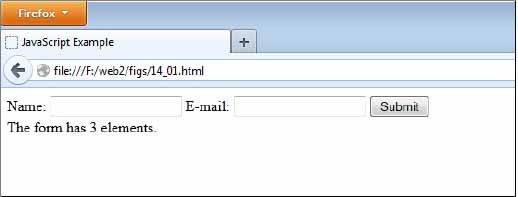
Figure 14-1 The number of elements in the form is displayed to the viewer.
Covering Two Length Properties
If you want to try to show the number of elements in the forms on a page when there is more than one form, you can use a more complex script that prints a message for each form on the page. Recall that because there is a forms array, you can find its length.
The length of the forms array is the number of forms on the page (similarly, the length property of a particular form is the number of elements in the form). To find the number of forms on the page rather than the length of a form, you can use the following code:
This syntax finds the number of forms on the page. Thus, you need to remember these points:
• document.forms.length finds the number of forms on the page.
• document.forms[x].length finds the number of elements in a specific form on the page, where x is the index of the form to be accessed.
This syntax might look a bit confusing, but just remember that one length property is for the forms in general, while the other length property is used on a specific form.
CAUTION
Remember the difference between document.forms.length and document.forms[x] .length. The former finds the number of forms on the page, while the latter finds the number of elements in a specific form (by replacing x with a number).
The following script uses both of the length properties and a loop to cycle through each form. The code displays the number of elements in each form on the page. First, the HTML code (save as lengths.html):
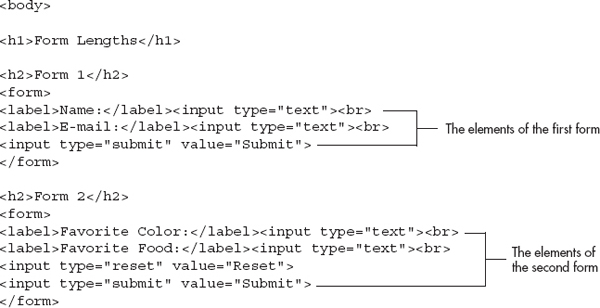

Next, the JavaScript code (save as lengths.js):

The code creates two forms in the HTML document. The script then opens a loop beginning at 0 (where arrays begin counting) and ending before it gets to the value of document.forms. length, which is the number of forms on the page. Because there are two forms (which will make 2 the value of document.forms.length), the count runs from 0 to 1 and then stops. The count allows you to access the forms array at indexes 0 and 1, which will turn out to be Form 1 and Form 2 in the HTML code.
The formnum variable has the value of the position number in the array plus one, which is the number of the form as seen in the HTML code. The script then writes the number of elements in each form on the page using the document.write() statements.
The forms array is used with the value of the count variable as the index number, which finds the number of elements in the specified form each time through the loop. Figure 14-2 shows the results of this code when run in a browser.
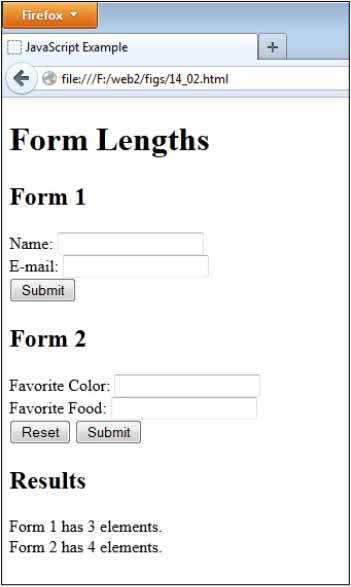
Figure 14-2 The number of elements in each form is displayed.
Using Form Names
Using form names allows you to name the forms on the page that you want to access later. This option can help eliminate any confusion between document.forms.length and document .forms[x].length because you won’t need to use the latter unless you’re trying to loop through each element in each form on the page.
To use a form name, you must add a name=“yourname” attribute to the opening form tag on the form you want to access. Replace yourname with a name you want to use for the form, as in the following code:

The name of the form is now info_form, and you can use this name to access the form in your script.
The name of the form allows it to become an instance of the form object that you can access through its name. To use JavaScript to access a form that uses a form name, you can use the syntax shown here:
Replace yourname with the name given to the form in the name=“yourname” attribute in its opening form tag. Thus, if you wanted to write a script to find the number of elements in the named form in this example, you could use the following code:
Notice how the form is accessed in the document.write() statement. Instead of the forms array, the name of the form is in its place. It can now access the properties of the form object and does so by accessing the length property.
Using an ID
The third way to access a form is to use an id attribute and to then use document.getElementById(). This is often the clearest way to access a form and its elements, because you can access each element by using its individual id, whereas the previous two access methods require you to know which array index the form is at or the form name and the element’s name.
NOTE
If you need a refresher on accessing elements using getElementById(), you can refer to Chapter 9.
If you wanted to write the script from the previous section using the id method, you could use the following HTML code:

Next, the JavaScript code:

Since you are familiar with using document.getElementById() from previous chapters, this should be a straightforward method for you.
The method you use to access a form and its elements will depend on the types of scripts you are writing. If you are using multiple forms on a page, then the forms array can be a handy way to cycle through each form. If you are trying to get as much backward compatibility with older HTML code or browsers as possible, using the name method may be the way to go. On the other hand, trying to validate in XHTML 1.0 Strict will require you to use an id to name each form element, so using the id method would be more appropriate in that case.
Using the Properties and Methods of the Form Object
The JavaScript form object will help you when you need to access certain elements or attributes of the form in a script. The form object has only a few properties and methods. The properties are described first.
Properties
The form object’s properties provide information you might need when working with forms in your scripts. Table 14-1 lists the properties of the form object and their values.
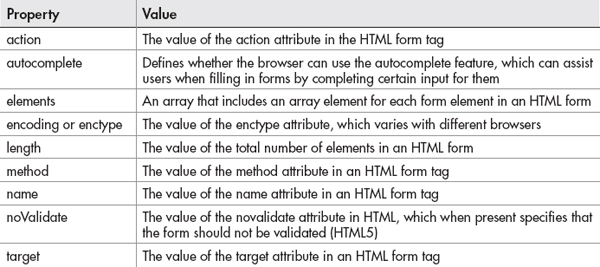
Table 14-1 Properties of the Form Object
Most of these properties just hold values corresponding to the various attributes in an HTML form tag. A few of them have different types of values, though, as explained next.
The action Property
This property allows you to access the value of the action=“url” attribute in the opening form tag. This attribute is used to send the form to a server-side script for processing (such as a Perl or PHP script). The following example shows how to access the property with a named form. First, the HTML code:

Next, the JavaScript code:
This script writes the URL on the page given in the action attribute. Figure 14-3 shows the result of this script when run in a browser.
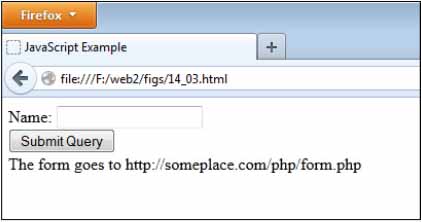
Figure 14-3 The value of the action attribute in the form is printed on the page.
The elements Property (Array)
The elements property is an array that allows you to access each element within a specific form in the same order it appears in the code, starting from 0. It works much like the forms array but has an entry for each element in a given form.
To use the elements array to access an element in a form, use the index number for the element you want to access. For instance, the following form has two elements:

To access the first element (the text box), you can use the syntax shown here:
Alternatively, if you want to use the forms array (assume this is the first form on the page), you could use this syntax:
Yet another option to access the text box is to name it (as with the form) and access it using its name. You can do this with each element, as well as the form itself; you can choose which method is best for accessing a form and its elements in each situation.
The following code gives the form and the text box a name, and allows you to access them using those names:

In this case, you could access the text box using the form name and the text box name, as in the syntax shown here:
Also, you can of course use the id method:

Then, you can access the input element using document.getElementById():
The encoding and enctype Properties
These properties both contain the value of the enctype attribute of a form tag, which is the type of encoding used for the data that is sent to the server from the form. The default is “application/x-www-form-urlencoded”.
The length Property
The length property holds the number of elements in a given form on a page. This chapter has already covered this property pretty extensively, so there’s no need to discuss it again here.
The method Property
This property holds the value contained in the method attribute of a form tag. Thus, if you’re sending the form to the server to be processed, you might use something similar to the following code:
The value of the method property for this form would be post because it’s within the method attribute of the form.
The name Property
This property holds the value of the form’s name, which is given to it in the name attribute of the form tag. You might have some code like this:

Here, the value of the name property is cool_form, because it’s the value inside the name attribute of the form.
The noValidate Property
This property contains the Boolean value of the novalidate attribute in a form tag (added in HTML5). If true, the form is not supposed to be validated when submitted. For more on HTML5 validation, see “HTML5 and Forms” later in this chapter.
The target Property
This property holds the value given in the target attribute in a form tag. For instance, you might have the following code:

Here, the value of the target property is _top, because it’s the value inside the target attribute of the form.
Methods
Now take a look at the form object’s methods. Selected methods will be discussed following Table 14-2.
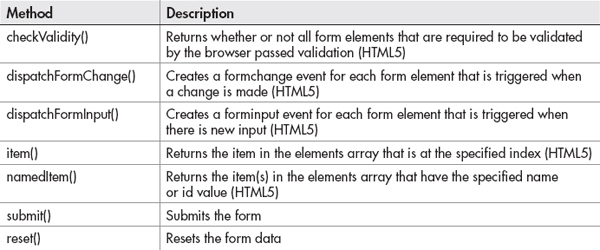
Table 14-2 The Methods of the Form Object
The checkValidity() Method
In HTML5, you can have the browser check whether a field contains data or validates against a pattern, which does not require JavaScript. You may wish to perform further actions; however, depending on whether or not all of the fields that require validation pass their respective tests. The checkValidity() function returns true if all elements that have validation requirements pass, or returns false if any of these elements fail validation. More information on how HTML5 affects forms can be found later in this chapter in the “HTML5 and Forms” section.
The reset() Method
This method enables you to reset a form from your script, which will clear any data entered by the user. For example, you could use the following code to reset a form once you have completed processing previously entered data:

Here, the form is reset after performing a simple operation (an alert) with the data input into a text field.
The submit() Method
This method allows you to submit a form without the viewer clicking the submit button. This can be useful if you need to provide an alternate way (aside from the submit input element) to submit the form. The following code shows an example of this. First, the HTML code:

Next, the JavaScript code:

Ensuring the Accessibility of Forms
Ensuring that your forms are accessible to viewers can be somewhat challenging because your preferred layout might not be interpreted properly by an assistive technology (such as Jaws or Homepage Reader). There are several things you can do to help ensure that most of your viewers can access and use your forms. You can place elements and their labels in the expected order, use <label></label> tags, or use <fieldset></fieldset> tags, and be sure not to assume the user has client-side scripting (such as JavaScript) enabled.
Using Proper Element and Label Order
In your HTML code, the order of your label text and form elements can help assistive technology in reading the form. For instance, consider the following input fields:
Here, an assistive technology looks for label text to appear before the form element. Since the first input element does not have any label text before it, the viewer is simply prompted for input, with no indication of what information to enter. Afterward, the label text “Name” is associated with the zip_code text box, which can cause the viewer to enter unexpected input.
To correct this, you can simply move the label text and place it before the form element, as in the following code:
Now, the assistive technology likely will pick up the form label and allow the user to enter the expected information. Using both the name and id attributes also helps, because various assistive technologies will pick these up as well.
This works for text boxes, text areas, and select boxes as well. However, when dealing with check boxes and radio buttons, many assistive technologies expect the element first, followed by the descriptive label. Thus, these should be switched around when being used.
When dealing with buttons (such as submit, reset, or created buttons), be sure to use the value attribute to describe what the button does, as that is what assistive technologies will likely expect.
Using <label></label> Tags
Using label tags helps you to further specify which label text belongs with which form element. Here is an example:
Here, since the label is in its expected position, you can simply apply the label tag. If you need to be more specific and point directly to the id of a form element, you can add the for attribute, as in the following code:
Here, you assign the for attribute of the opening label tag the value of the id attribute for the form element that will use the label text contained within the <label> and </label> tags. In the preceding example, the for attribute contains yourname, which links the text to the element with the id of yourname in the HTML code.
Using <fieldset></fieldset> Tags
Using a fieldset can be helpful when dealing with radio buttons and check boxes in order to group them together into a logical set. Using a legend tag to label the options to choose from allows the user to know what is expected to be selected. The following code uses a fieldset to group together a group of radio buttons used to select a type of fruit:

Here, you group all of the radio buttons within the <fieldset> and </fieldset> tags and use a legend tag after the opening fieldset tag to give the group a label. Then, each element is labeled normally within the fieldset (also using the label tags).
Not Assuming Client-Side Scripting
When coding a form initially, it’s best not to assume JavaScript or another client-side technology will be available. If JavaScript is required to make the form usable, then a number of users will not be able to use it because they will have JavaScript disabled for any number of reasons, such as security.
The best practice is to allow the form to be sent to the server side (which will handle the form and provide the most important validation routines) even if JavaScript is unavailable. Code like the following wouldn’t be usable for those without JavaScript:
In this case, a JavaScript event handler and method are required to submit the form. It would be better to use the traditional submit input element to create a submit button.
If you are using some JavaScript validation, you could use code such as the following:

This allows you to run JavaScript if it is available (by creating an event listener for the submit event). Otherwise, the JavaScript submit event will be ignored and the form will be submitted to the server-side script for validation and handling. If JavaScript is available, the client-side validation routine can save a trip to the server side. If not, the server-side script will need to do the work, but the user will still be able to use the form as expected.
Validation
Validating JavaScript forms is extremely useful. For example, you can validate input before it is submitted, to help reduce the number of forms with incomplete or inaccurate information. Validation of form data prior to submission to, say, a Common Gateway Interface (CGI) script, PHP script, or a Java servlet can save time and reduce load on the server.
Simple Validation
In the last chapter (Try This 13-1), you performed some simple validation on form input by using the submit event to execute a function when the form is submitted and testing the input for particular characters (the @ and . in an e-mail address). You also learned about regular expressions, which can also be helpful when validating form input.
For an example, suppose you had this HTML code for a form:

If you use addEventListener() to handle the submit event, you can validate the entered name and allow the default action to occur (submitting the form content to the server), or you can prevent the default action and send an error message if the name does not validate according to your specified rules. Here is an example of this:

As you can see, this uses a regular expression (see Chapter 13) to limit the type and number of characters that are allowed in the name field. It uses the letter ranges A–Z and a–z to allow all letters, ’ to allow apostrophes (for names such as O’Neil), - to allow hyphens (the hyphen is escaped to avoid being confused with a new range), and a blank space to allow for spaces. It then uses {2,50} to ensure that there are at least two characters in the name and no more than 50 characters. The ^ and $ are used to match the string from beginning to end, rather than stopping after the first valid character. If the name does not validate, the form is not submitted (event.preventDefault() stops the submission) and the user is sent an alert. Otherwise, the form is submitted normally to the server for server-side processing.
If you need to use the DOM0 method in older browsers where the event object is not available, you will want the function that handles the event to return true if the name validates or false if it does not. The function itself can do everything else, but it needs to have a return statement that sends back a value of true or false to the event handler. For example, you could use the following code to perform the same test using the DOM0 method:
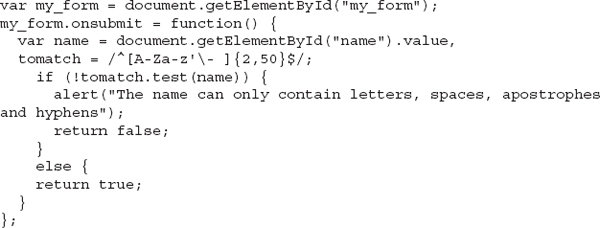
Here, the test is performed. If the name does not validate, the alert is sent and the function returns false. As you will recall, if a function executes a return statement, no statement following it in the function will be executed. Thus, the return statements must come after any actions you wish to perform.
Techniques
For the most part, validation can be as simple or as complex as you need it to be for your purposes. All you need to do is create your own custom functions to validate the form fields of your choice based on the information needed.
For instance, you could check whether a field contains five digits for a typical Zip code by using a regular expression. If it does not, then you can send an alert telling the viewer the Zip code is invalid and asking for it to be reentered. The following code shows a way to do this. First, the HTML code:

Next, the JavaScript code:

The code uses the regular expression to check for five digits. If anything other than five digits is entered, then the function will return false. You can, of course, expand this to allow for the extra four digits that are sometimes used to designate more precisely a specific area within a Zip code. To do so, add another input field and require that it have four digits if a value is entered in that second field.
You can make the validation as strict or as loose as you need it in your JavaScript. Keep in mind, though, that at the application layer (your server-side script or program), you will need to take extra care with your validation routines to ensure that bad and/or malicious data cannot be submitted to your application.
TIP
One way to find validation scripts is to try checking some JavaScript sites on the Web. A number of them have special functions that are made to validate different types of data. This can save you some work if you can find a function to suit your purposes.
Check Boxes and Radio Buttons
When using check boxes and radio buttons, you may simply want to know if they have been “checked” by the user. For example, you could have the following form:

In this case, you want to be sure the user checks the “agree” box before the form can be submitted for the user to sign up. To check for this in JavaScript, you can use the checked property for the checkbox element, which returns true if the element is checked and false if it is not. The following code shows an example of this:

Here, if the “agree” checkbox is not checked, the form will not be submitted. The user will receive the alert saying that the “Agree to Terms” checkbox must be checked.
If you are working with a set of radio buttons and just want to ensure that one of the options has been checked, you can combine the document.getElementsByName() method (see Chapter 9) and the checked property to determine if this is the case. For example, suppose you had the following form:
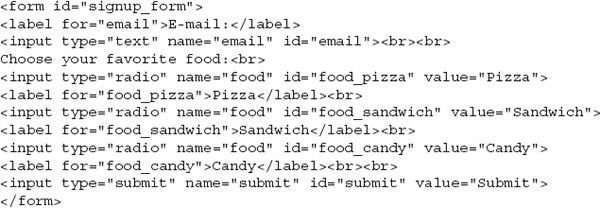
The name attribute for each radio button of the same category will be the same (here it is “food”) so that only one option can be selected. In order to ensure that one of the options was indeed selected, you could use the following code:
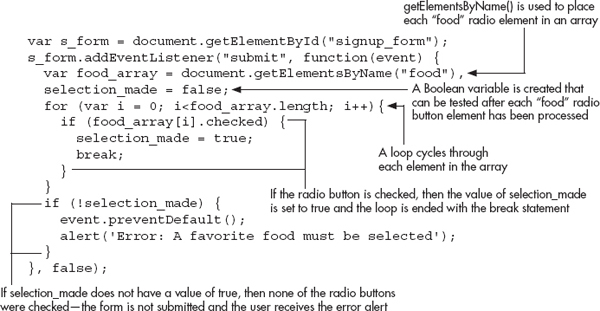
Ask the Expert
Q: Is validation necessary? After all, couldn’t it be handled by the server-side application?
A: Yes, but using client-side validation can help you save strain on your server, since those who have JavaScript enabled won’t need to access the server-side application each time invalid information is entered. It can also be helpful to the users, who will not need to reload the entire page to correct any invalid information.
Q: What types of input can I validate?
A: For the most part, you can validate anything you like in the manner you see fit. You can validate dates, names, times, addresses, e-mail addresses, phone numbers, or anything else you might need.
Q: Can I validate the selections in a select box or the text in a text area, or maybe some of the other input types?
A: In some of these cases, you will already have your own values built into the elements. However, if you can, you should still validate those values against other information to be sure the information you receive matches your needs. You just need to adjust your function to perform the needed tasks based on the different types of input devices (text areas, radio buttons, and so on).
Q: I don’t use server-side scripts, but I use JavaScript for fun and want to validate the information. Do I really need to add a server-side script?
A: The need for a server-side script depends on your purposes. If you have a form that needs to have information saved, sent by e-mail, or sent to a database, then you need a server-side application.
Here, each of the radio button elements that has “food” as the value of its name attribute is placed into food_array. This allows you to use a loop to cycle through each of the radio buttons to see if it has been checked. A Boolean variable named selection_made is set to false initially. Within the loop, if the script finds that a radio button has been checked, it will set selection_ made to true and exit the loop using the break statement. You can do this since only one radio button can be checked—you won’t need to continue checking after a positive result is found. If selection_made remains false after running the loop, then the form submission is canceled and the user receives the error alert instead.
| Try This 14-1 | Request a Number |
 |
In this project, you create a script for basic validation of a phone number entered by the viewer, such as 222-222-2222. |
Step by Step
1. Create an HTML page with a form and a text box with the label text “Phone Number (XXX-XXX-XXXX):” and an id of “phone”. Make sure the form has a submit button. Insert the necessary script tags after the form to call an external JavaScript file named prjs14_1.js. Save the HTML file as pr14_1.html. When complete, the HTML code should look like this:

2. Create an external JavaScript file and save it as prjs14_1.js. Use it for step 3.
3. Use a regular expression to ensure that the data entered into the text box is in the format XXX-XXX-XXXX. If it is, send an alert saying “Phone number validated.” Otherwise, send an alert saying “Invalid phone number entered. Valid format is XXX-XXX-XXXX.” When complete, the JavaScript code should look like this:
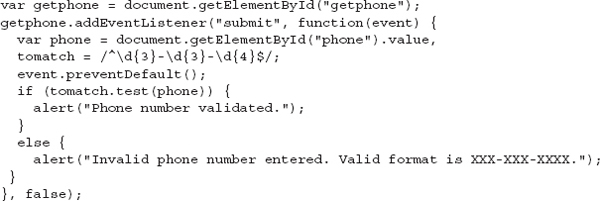
4. Save the JavaScript file and open the HTML file in your browser. See if it works by typing various values into the text box and submitting the form.
Try This Summary
In this project, you used your knowledge of JavaScript and forms to create a script to validate a form. The script validates a time entry by the viewer to see if it is a valid phone number by a particular set of standards.
HTML5 and Forms
HTML5 provides several new elements, as well as a number of new input types and attributes. It also provides a way for the browser to perform validation on fields on the client side, easing the burden on JavaScript in browsers that support the new features.
New Elements
The new form-related elements in HTML5 are listed in Table 14-3.

Table 14-3 New Form-Related Elements in HTML5
These elements allow you to provide additional information to the viewer or to perform other helpful tasks. You will look at the meter and progress elements in this section, but for more details on any of these elements, including which browsers support each one, see wufoo.com/html5/.
The meter Element
The meter element is used to display a value based on a scale you define. For example, if you decided to use a scale of 0–100, you would give the min attribute a value of 0 and the max attribute a value of 100. The actual value to be displayed on that scale is provided in the value attribute. For example, to show 55 on a scale of 0–100, you could use the following code:
This will display a meter bar in browsers that support it, showing the bar filled to 55 out of the 100 units available. Figure 14-4 shows how this looks in a supported version of Google Chrome.
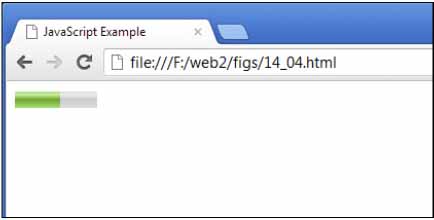
Figure 14-4 A meter bar is displayed.
For browsers that do not support the element, you can provide default text to be displayed by inserting the text within the opening and closing tags, as in the following code:
This will simply display 55 on the page where the meter would have appeared.
This can be used in combination with JavaScript to display helpful information to the user, such as how many questions have been correctly answered in a quiz. For example, suppose you had the following HTML code:

Here, a form is created for a quick math quiz, allowing the viewer to enter the answers into text boxes and then submit the answers to be checked. An empty div with an id of grade will be used to display the answer via JavaScript. The following code shows how the meter tag could be used as a visual aid in displaying the number of correct answers:

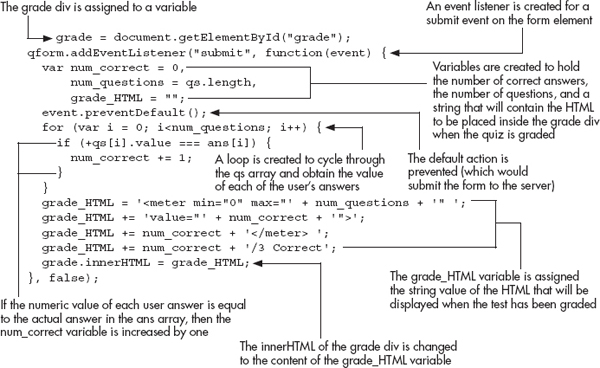
Here, the test is graded when the form is submitted. A variable named num_correct is created with an initial value of zero, a variable named num_questions obtains the number of questions in the quiz by grabbing the length of the qs array, which contains each text box input element, and a variable name grade_HTML is assigned an empty string that will be filled in with the meter tag and other text to display the results.
A loop is created to iterate over the qs array, get each value, and determine if it is equal to its corresponding correct answer in the ans array. Notice that the unary + operator is used to attempt to coerce the user’s entry into a number before comparing it to the correct answer, since each text box will return a string by default. If the answer is correct, the one is added to the num_correct variable.
The next lines of code create the HTML string that will eventually be placed within the grade div. Notice how the max attribute of the meter tag is assigned the value of the num_questions variable, and how the value attribute is assigned the value of the num_correct variable. An additional message is displayed after the meter element to show the user what type of results the meter is displaying (for example, if two answers were correct, the message “2/3 Correct”).
In this case, if the user does not get all the answers correct, the entries can be edited and submitted to be checked again until a 3/3 is obtained. Figure 14-5 shows the result of this script when two of the answers are correct.

Figure 14-5 The meter is displayed to show how many questions were answered correctly.
The progress Element
The progress element is similar to meter, but displays a percentage rather than a scalar value. For example, to show 25 percent out of 100 percent on a progress bar, you could use the following code:
As with meter, you can use the max attribute to set the maximum and the value attribute to set the percentage value within a range if zero up to the max value. You could edit the previous meter JavaScript code to use a progress bar to display a percentage grade for the quiz if desired, using the following code:
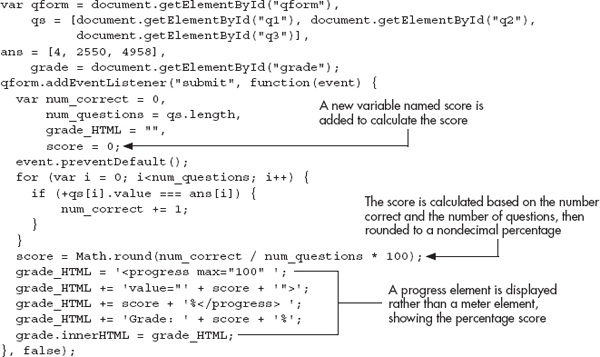
Here, some changes are made to calculate the percentage score that will be used in the progress element. The progress element is then generated based on the percentage score. Figure 14-6 shows the result of this script when two out of three answers are correct.
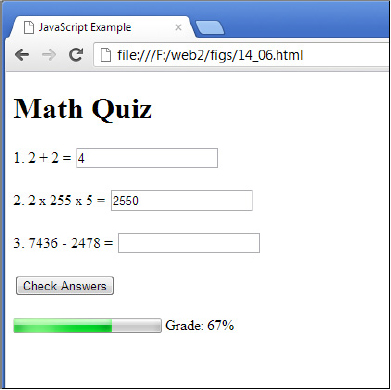
Figure 14-6 The result is displayed as a percentage using the progress element.
New Input Types
In addition to new elements, HTML5 adds a number of new input types that can be used for the input element. Table 14-4 lists the new additions.
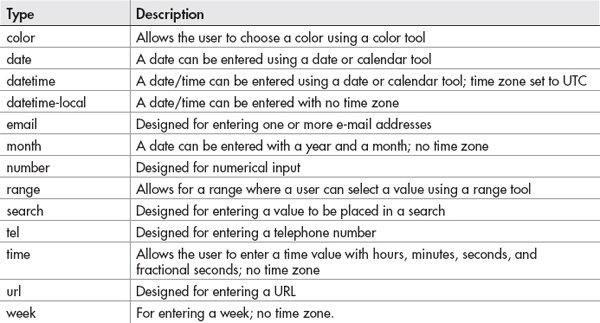
Table 14-4 New Input Types in HTML5
You will notice that some of these input types allow for the use of a tool by the user, such as the color input type. Browsers may implement these in different ways, but those that support one or more of the new input types often make it easier for the user to enter each specific type of value and/or make the value entered easier to validate. An example of using the new color type is shown in this code:
As you can see, you can plug in the specific type inside the type attribute to make use of it. Since these fields ask for specific types of values, the browser is able to perform its own validation on the fields, which is helpful when it is supported. This will be discussed further in the “HTML5 Form Validation” section later.
New Attributes
HTML5 also brings new attributes that can be used with forms and/or form elements. These are listed in Table 14-5.
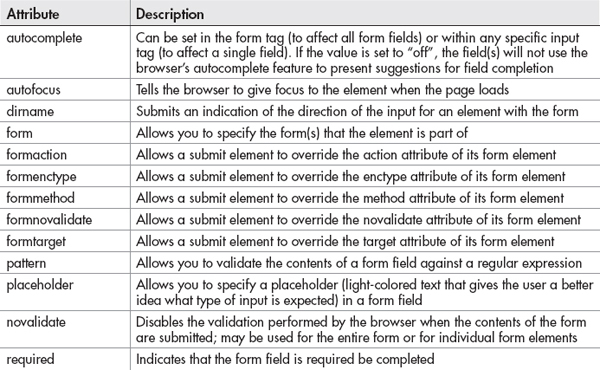
Table 14-5 New Attributes in HTML5 Forms/Form Fields
Many of these allow you to override attributes in the main form element using the submit element. There are also some attributes such as required, novalidate, and pattern that assist with form validation, which is discussed in the next section.
HTML5 Form Validation
HTML5 allows the browser to validate various input types automatically. This can be overridden by using the novalidate attribute in the form tag to disable browser input validation for all of a form’s fields or by using it in individual form fields so that they are not validated.
If you decide to allow the browser to validate fields, the new input types will have certain validation methods used on them to ensure that the expected type of information is entered. Each field is optional by default, though you can make it required by adding the required attribute to each field that needs to be completed. For example, the browser will validate the following form and will require that the URL field be completed:

Figure 14-7 shows what happens when the required field is not completed in a supported browser. Figure 14-8 shows the result of entering an invalid URL in the URL field in a supported browser.

Figure 14-7 The field must be completed to validate.
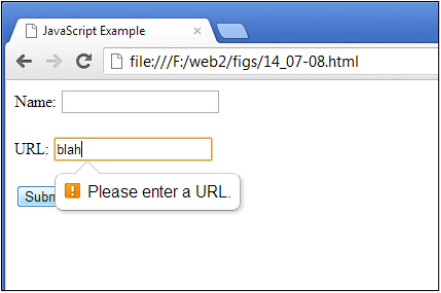
Figure 14-8 The field must contain a valid URL to validate.
You can also use the pattern field so that the browser will validate a field according to a regular expression. For example, if you want the name field from the previous form to contain only letters and spaces, you could use the following code:
The only drawback is browser support. If you need to validate the input on the client side in browsers that do not support the particular input types or validations used in HTML5, then you will need to write some JavaScript as a backup. For example, suppose you had the following form:

If a browser does not support the pattern attribute and you still want to make sure the field contains only letters and spaces, then you will need to write a script to ensure that the field is still validated. In this case, you could simply use the following code to validate the name field when the submit button is clicked.

This simply uses the desired pattern as a regular expression in JavaScript and runs the test method to see if the input matches the pattern. If not, an alert is sent to the viewer so that the name can be corrected.
HTML5 provides numerous new and helpful features to forms. At the time of this writing, JavaScript backups may be necessary for client-side validation. As more users move to newer browsers and browser support for all of the new features is increased, these new tools will become even more helpful to you as a developer.
NOTE
For more details on any of the HTML5 form improvements, including which browsers support each one, see wufoo.com/html5/.
| Try This 14-2 | Validate a Phone Number with HTML5 or JavaScript |
 |
In this project, you will build on the previous project by creating a form that will validate a phone number using the new HTML5 pattern attribute. If the browser does not support HTML5, a backup JavaScript validation is run instead. |
Step by Step
1. Create an HTML document and add script tags so that the HTML file will call an external JavaScript file named prjs14_2.js. Create a form with an id of “getphone”, and add a text box with an id of “phone” to obtain a phone number. The text box should use the pattern attribute with a regular expression that will validate the phone number if the format is XXX-XXX-XXXX. It will also be a required field. Make sure the form contains a submit button. Save the HTML file as pr14_2.html. When complete, the HTML code should look like this:

2. Create a JavaScript file and save it as prjs14_2.js. Use it for step 3.
3. Create a script that will back up the HTML5 validation when the form is submitted. If the field does not validate, send an alert saying “Invalid phone number entered. Valid format is XXX-XXX-XXXX.” Otherwise, allow the form to be submitted. When complete, the JavaScript code should look like this:

4. Save the JavaScript file and open the HTML file in your browser. Check to see whether the validation system works.
Try This Summary
In this project, you used your knowledge of JavaScript and HTML5 forms to create a validation system that checks for a valid phone number in HTML5 and backs up the validation with JavaScript code.
Chapter 14 Self Test
1. Each time you add a set of <form> and </form> tags to an HTML document, a(n) _______ object is created.
2. The forms __________ allows you to access a form using an index number.
3. Which of the following would access the fourth form on a page?
A. document.forms[4]
B. document.forms[3]
C. document.forms(4)
D. document.forms(3)
4. Which of the following would find the number of elements in the third form on a page?
A. document.forms[2].length
B. document.forms[3].length
C. document.forms.length
D. document.forms(3).length
5. Which of the following holds the value of the number of forms in a document?
A. document.forms[0].length
B. document.form.length
C. document.forms.length
D. document.forms[1].length
6. Using form __________ or __________ allows you to name the forms on the page that you want to access later.
7. Which of the following accesses the value of an element named e1 in a form named f1?
A. document.f1.e1.value
B. document.e1.f1.value
C. document.f1.e2.value
D. document.forms1.e1.value
8. The __________ property allows you to access the value of the action=“url” attribute in the opening form tag.
9. The __________ property is an array that allows you to access each element in a specific form.
10. The __________ attribute in HTML5 allows you to give a form field a regular expression it must validate.
11. The __________ method allows you to reset a form using your script.
12. Which of the following would add a valid meter tag to the document to show 8 on a scale of 0 to 10?
A. <meter min=“0” max=“10” value=“7”>8</meter>
B. <meter min=“4” value=“8”>8</meter>
C. <meter min=“0” max=“10” value=“8”>8</meter>
D. <meter min=“0” max=“100” value=“8”>8</meter>
13. One way to help with form accessibility is to use the __________ tags to identify what field a piece of text is describing.
14. The __________ method allows you to submit a form without the viewer clicking the submit button.
15. Which of the following HTML5 form attributes is used for fields that must be filled in by the user to validate?
A. obligatory
B. needed
C. required
D. compulsory
..................Content has been hidden....................
You can't read the all page of ebook, please click here login for view all page.
